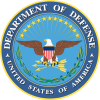Guam: Difference between revisions
Knorrepoes (talk | contribs) m (Text replacement - "*[[" to "* [[") |
Knorrepoes (talk | contribs) m (Text replacement - "===Official blazon===↵↵===Origin/meaning===" to "{| class="wikitable" |+Official blazon |- |'''English''' | blazon wanted |} ===Origin/meaning===") |
||
| (6 intermediate revisions by the same user not shown) | |||
| Line 1: | Line 1: | ||
'''GUAM (Guåhan)''' | '''GUAM (Guåhan)''' | ||
[[File:guam.gif|center|Arms (crest) of {{PAGENAME}}]] | [[File:guam.gif|center|Arms (crest) of {{PAGENAME}}]] | ||
= | {| class="wikitable" | ||
|+Official blazon | |||
|- | |||
|'''English''' | |||
| blazon wanted | |||
|} | |||
===Origin/meaning=== | ===Origin/meaning=== | ||
Guam does not use proper arms, but only the above seal. | Guam does not use proper arms, but only the above seal. | ||
The coconut tree, also known as the "Tree of Life" holds a dominant position on Guam's symbol. The shape of the seal is that of a Chamorro sling stone used as a weapon for warfare and hunting. The sling stone was quarried from basalt and coral. <br>The Coconut Tree, growing in infertile sand, symbolizes self-sustenance and determination to grow and survive under any circumstance, with its fronds open to the | The coconut tree, also known as the "Tree of Life" holds a dominant position on Guam's symbol. The shape of the seal is that of a Chamorro sling stone used as a weapon for warfare and hunting. The sling stone was quarried from basalt and coral. <br>The Coconut Tree, growing in infertile sand, symbolizes self-sustenance and determination to grow and survive under any circumstance, with its fronds open to the sky-defies the elements to bend its will. Its bent trunk attests to a people which have been tested by famine, natural calamities, genocide and foreign wars but have continued to endure as a race. <br>The Flying Proa, a seagoing craft built by the Chamorro people, which was fast and agile in the water required great skill to build and sail. <br>The River channel, where fresh water rush out to interact with the ocean, symbolizes a willingness to share the resources of the land with others. <br>The permanence of the land mass of Hila'an in the background demonstrates the Chamorro's commitment to their homeland and environment, be it sea or land. Also in the background, "Two Lovers' Point" juts majestically into the endless waters of the sea, portraying the people's faithful commitment to passing their proud heritage, culture, and language to the endless sea of future generations | ||
==Arms of towns and villages== | ==Arms of towns and villages== | ||
| Line 22: | Line 21: | ||
* [[Archdiocese of Agaña]] | * [[Archdiocese of Agaña]] | ||
{{us}} | |||
{{media}} | {{media}} | ||
[[Literature]] : background from wikipedia | [[Literature]] : background from wikipedia | ||
Latest revision as of 14:01, 29 January 2024
GUAM (Guåhan)
| English | blazon wanted |
Origin/meaning
Guam does not use proper arms, but only the above seal.
The coconut tree, also known as the "Tree of Life" holds a dominant position on Guam's symbol. The shape of the seal is that of a Chamorro sling stone used as a weapon for warfare and hunting. The sling stone was quarried from basalt and coral.
The Coconut Tree, growing in infertile sand, symbolizes self-sustenance and determination to grow and survive under any circumstance, with its fronds open to the sky-defies the elements to bend its will. Its bent trunk attests to a people which have been tested by famine, natural calamities, genocide and foreign wars but have continued to endure as a race.
The Flying Proa, a seagoing craft built by the Chamorro people, which was fast and agile in the water required great skill to build and sail.
The River channel, where fresh water rush out to interact with the ocean, symbolizes a willingness to share the resources of the land with others.
The permanence of the land mass of Hila'an in the background demonstrates the Chamorro's commitment to their homeland and environment, be it sea or land. Also in the background, "Two Lovers' Point" juts majestically into the endless waters of the sea, portraying the people's faithful commitment to passing their proud heritage, culture, and language to the endless sea of future generations
Arms of towns and villages
As far as I know, no towns or village on the island uses arms.
Religious arms
US heraldry portal
This page is part of the US heraldry portal |
Heraldry of the World |
|
US heraldry:
|
Ecclesiastical Heraldry of the USA:
Military Heraldry: |
Contact and Support
Partners:
Your logo here ?
Contact us
© since 1995, Heraldry of the World, Ralf Hartemink 
Index of the site
Literature : background from wikipedia















